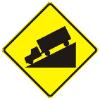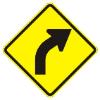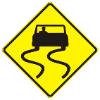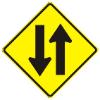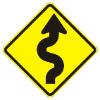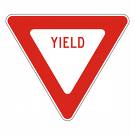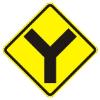Driving Exam
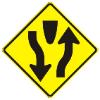
Practice test for the Ohio driving exam!
- 1.
Applicants under 16 years of age must practice with?
- A.
A licensed driver.
- B.
Any of their friends.
- C.
A licensed parent or legal guardian seated next to them.
- D.
A licensed driver 21 years of age or older occupying the seat next to them.
- E.
Both c & d
Correct Answer
C. A licensed parent or legal guardian seated next to them.Explanation
Applicants under 16 years of age must practice with a licensed parent or legal guardian seated next to them. This requirement ensures that young drivers receive guidance and supervision from an experienced adult while they are learning to drive. It also helps to ensure their safety and the safety of others on the road. Practicing with a licensed parent or legal guardian allows for immediate intervention and instruction in case of any mistakes or emergencies.Rate this question:
-
- 2.
When an Emergency Vehicle approaches the driver must?
- A.
Immediately drive to a position parallel to the right edge or curb of the road or highway and stop.
- B.
Continue driving keeping aware of the emergency vehicle.
- C.
Slow down and keep out of the way of the emergency vehicle.
- D.
Immediately stop where you're at and let the emergency vehicle pass.
- E.
Continue driving.
Correct Answer
A. Immediately drive to a position parallel to the right edge or curb of the road or highway and stop.Explanation
When an emergency vehicle approaches, the driver must immediately drive to a position parallel to the right edge or curb of the road or highway and stop. This is because emergency vehicles need clear passage to reach their destination quickly and safely. By moving to the right and stopping, the driver allows the emergency vehicle to pass without any hindrance. This action helps to ensure the safety of both the emergency responders and other road users.Rate this question:
-
- 3.
On a two lane road a vehicle should.
- A.
Drive in right lane unless its going faster than the other vehicles then drivers can move to left lane.
- B.
Drive in right lane except when passing.
- C.
Drive in the left lane except when passing.
- D.
Drive in left lane at all times.
- E.
Drive in right lane at all times.
Correct Answer
B. Drive in right lane except when passing.Explanation
On a two lane road, the correct answer is to drive in the right lane except when passing. This means that drivers should generally stay in the right lane, but if they need to overtake another vehicle, they can temporarily move to the left lane. This ensures smoother traffic flow and reduces the risk of accidents by keeping slower-moving vehicles in the right lane and allowing faster-moving vehicles to pass on the left.Rate this question:
-
- 4.
What is the most important driving technique to avoid crashes when driving in icy or snowy conditions?
- A.
Add extra weight to the vehicle to improve traction
- B.
Get of the highways as quickly as possible
- C.
Engage four-wheel drive on the vehicle
- D.
Reduce speed and increase following distance
- E.
Both a & c
Correct Answer
D. Reduce speed and increase following distanceExplanation
The most important driving technique to avoid crashes when driving in icy or snowy conditions is to reduce speed and increase following distance. This is because icy or snowy conditions reduce traction, making it harder to control the vehicle. By reducing speed, the driver has more time to react to any potential hazards or changes in road conditions. Increasing the following distance allows for more stopping distance, reducing the risk of rear-end collisions. Adding extra weight to the vehicle may improve traction to some extent, but it is not the most important technique. Engaging four-wheel drive can help with traction, but it does not address the need to reduce speed and increase following distance.Rate this question:
-
- 5.
A flashing red traffic signal at an intersection has the same requirements as which of the following?
- A.
A slow sign
- B.
A yield sign
- C.
A stop sign
- D.
An intersection sign
- E.
No such sign
Correct Answer
C. A stop signExplanation
A flashing red traffic signal at an intersection has the same requirements as a stop sign. This means that drivers must come to a complete stop at the intersection, yield the right-of-way to other vehicles and pedestrians, and proceed only when it is safe to do so. Both the flashing red signal and the stop sign indicate the same level of caution and adherence to traffic rules at an intersection.Rate this question:
-
- 6.
The application for an operator's license must be signed by the parent or guardian when the applicant is under what age?
- A.
16
- B.
20
- C.
21
- D.
18
- E.
22
Correct Answer
D. 18Explanation
The correct answer is 18. In many jurisdictions, individuals under the age of 18 are considered minors and require parental or guardian consent for certain legal documents, such as an operator's license application. This is to ensure that young individuals have the guidance and support of a responsible adult before obtaining a license and operating a vehicle.Rate this question:
-
- 7.
Unless it's posted otherwise, the speed limit in a residential area is:
- A.
25 mph
- B.
20 mph
- C.
35 mph
- D.
15 mph
- E.
10 mph
Correct Answer
A. 25 mphExplanation
The correct answer is 25 mph. In residential areas, the speed limit is typically set at 25 mph to ensure the safety of pedestrians and residents. This speed limit allows drivers to have enough time to react to any unexpected situations and reduces the risk of accidents. It also helps to minimize noise and maintain a peaceful environment in residential neighborhoods.Rate this question:
-
- 8.
Child restraints are required for which of the following?
- A.
All children who are under the age of 4 and children who weigh less then 40 lbs.
- B.
All children for whom the driver of the car is the parent or guardian
- C.
All children who are seated in the front seat
- D.
All children who are under the age of 6 when air bags are not available
- E.
None of the above
Correct Answer
A. All children who are under the age of 4 and children who weigh less then 40 lbs.Explanation
Child restraints are required for all children who are under the age of 4 and children who weigh less than 40 lbs. This is because younger children and those with a lower weight are more vulnerable to injuries in the event of a car accident. Child restraints, such as car seats or booster seats, provide additional protection and ensure that children are securely restrained while traveling in a vehicle. It is important for parents and guardians to follow these guidelines to prioritize the safety of their children on the road.Rate this question:
-
- 9.
When traveling on on a highway divided into 4 traffic lanes, which vehicles are required to stop for a school bus that has stopped to unload children?
- A.
Only vehicles approaching the rear of the bus traveling in the same direction as the bus
- B.
All vehicles approaching the bus from either direction
- C.
No one is required to stop unless children are in view
- D.
All vehicles may pass the bus after providing an audible signal
- E.
A & B
Correct Answer
A. Only vehicles approaching the rear of the bus traveling in the same direction as the busExplanation
Vehicles approaching the rear of the bus traveling in the same direction as the bus are required to stop for a school bus that has stopped to unload children. This is because the law requires vehicles traveling in the same direction as the bus to stop and wait until the bus has finished unloading the children and the bus's stop sign is retracted. Vehicles approaching the bus from the opposite direction are not required to stop unless there is a physical barrier such as a median dividing the highway.Rate this question:
-
- 10.
- A.
Divided highway ends, two-lane highway begins
- B.
Watch for foreign objects, may need to swerve
- C.
Go right then left
- D.
Go left then right
- E.
Two-lane highway ends, divided highway begins
Correct Answer
E. Two-lane highway ends, divided highway begins -
- 11.
- A.
Trucks on wedges
- B.
Loading zone
- C.
"Trucks Use Low Grade"
- D.
Approaching a downgrade.
- E.
C & D
Correct Answer
E. C & D -
- 12.
- A.
Right turn
- B.
Sharp right turn
- C.
Dead end
- D.
Intersection ahead
- E.
Merging traffic
Correct Answer
B. Sharp right turn -
- 13.
- A.
Slight curve to the right
- B.
Sharp turn to the right
- C.
Hill ahead
- D.
Fork in the road
- E.
None of the above
Correct Answer
A. Slight curve to the right -
- 14.
- A.
Car ahead swerves, be careful
- B.
Burn outs permitted
- C.
Slippery when wet
- D.
Curvy road ahead
- E.
Narrow road ahead
Correct Answer
C. Slippery when wet -
- 15.
- A.
Watch for oncoming traffic
- B.
Clearance from bottom to top
- C.
Go down the road then turn around
- D.
Theres a decrease the an increase
- E.
Two way traffic
Correct Answer
E. Two way traffic -
- 16.
- A.
You are approaching a series of curves
- B.
Turn left then right
- C.
Slow down , drive carefully
- D.
A & B
- E.
A & C
Correct Answer
E. A & C -
- 17.
- A.
Slow down and proceed with caution
- B.
Stop only if other traffic is affected
- C.
Look and give way to all oncoming traffic
- D.
B & C
- E.
A & C
Correct Answer
D. B & C -
- 18.
- A.
Fork in the road
- B.
Road branches off the the right and the left
- C.
Oncoming traffic from right and left
- D.
Three lanes meet in one spot
- E.
A & C
Correct Answer
B. Road branches off the the right and the left -
Quiz Review Timeline +
Our quizzes are rigorously reviewed, monitored and continuously updated by our expert board to maintain accuracy, relevance, and timeliness.
-
Current Version
-
Mar 22, 2023Quiz Edited by
ProProfs Editorial Team -
Jul 02, 2009Quiz Created by
Jdstreight
- Aptitude Test Quizzes
- Course Test Quizzes
- English Test Quizzes
- FCAT Quizzes
- General Knowledge Quizzes
- Intelligence Test Quizzes
- Medical Test Quizzes
- Mock Test Quizzes
- Philosophy Test Quizzes
- Practice Test Quizzes
- Pretest Quizzes
- Safety Test Quizzes
- Skill Assessment Quizzes
- Spelling Test Quizzes
- Standardized Test Quizzes



